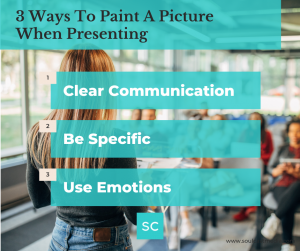Creating A Memorable Presentation
When you present to an audience, you want to engage them, so they will remember your key takeaways. One way to do this is to paint a picture with your words. You want each audience member to relate to what you are saying.
According to research, only 35% of people will be able to recall takeaways from an oral presentation. This is why it is so essential for you to evoke your audience’s emotions by using communication techniques to help them create mental images.
Below are three communications techniques you can use to create a memorable presentation.
1. Clear Communication
If you want your audience to visualize the mental picture you are trying to paint, you must use clear communication. When you are clear, your audience will remain engaged.
Consider the following:
- Avoid Filler Words – Filler words such as um, ah, you know, etc., can distract from your message. For example, saying, “The ah sky was um, just, so brilliant and um blue.” Compare this to saying, “The sky was a brilliant shade of blue.” Read both aloud and listen for the difference. In the second example, you most likely immediately visualize a brilliant blue sky. In the first example, you may imagine a blue sky, but it is more difficult to understand what you are supposed to visualize.
- Be Succinct – When you are succinct, your audience will be able to understand your message without getting lost. You need to cut out anything distracting from your message to be straightforward. For example, many people use stories to paint pictures for their audience. However, if your story goes off on tangents, or doesn’t have a point, you will want to cut it. As much as you may love the story, it won’t help you deliver your message.

- Pacing – When presenting to an audience, you must consider your pace. This means how fast or how slow you speak. If you are trying to paint a picture, you will want to vary your speed. For example, if you talk too quickly, your audience may lose critical details about the image you are trying to convey. On the other hand, if you speak too slowly, your audience may disengage. Practice your pacing by recording yourself giving your presentation.
Painting a picture when presenting requires clear communication. The more precise you are, the more easily your audience can visualize your message.
2. Be Specific
Specifics will help your audience create mental images of your message. You will want to be very careful about your words and details so your audience will remain engaged.
Consider the following:
- Word Choice – The words you choose can significantly impact whether or not your audience can visualize your message. It is essential to choose the right words. For example, you could say, “It was a cloudy day.” This gives your audience a reference point. However, you could be even more descriptive with your words. You could say, “The clouds were dark and heavy.” This gives your audience more information so they can see the dark cloudy sky.
- Details – Any details you can provide the audience will help them see the picture you are painting. For example, you could say something like, “I picked up the tiny flower.” This tells your audience that the flower was small. However, it doesn’t go into much detail. You are letting your audience decide the color, size, and other details instead of painting the picture for them. Rather, you could say, “I picked up the tiny yellow flower with my fingers. The petals were as small as grains of rice.” This shows how tiny the flower was, what color it was and how you picked it up. Now, your audience can see the entire image unfold in their heads.
- Senses – As you prepare your presentation, consider using the five senses to help you give specifics to your audience. For example, what can you see, hear, touch, taste, and smell? You could say something like, “The sandwich I ate was dry, and smelled like day-old bread. The wind whistled through the sandwich packaging, which became louder as the wind picked up speed. I forced another bite of the sandwich as the dark grey clouds approached.” Using all of the senses will help you paint the picture and keep your audience engaged.
3. Use Emotions
Evoking emotions can help your audience visualize your message and help them remember it after your presentation. There are several ways to evoke emotions and paint a picture for your audience when presenting.
Consider the following:
- Metaphors/Similies – Metaphors and similies are great ways to evoke emotion. This is because metaphors/similies show the similarities between a situation most people are familiar with and your message. For example, you could say, “I felt like I had been tossed aside like a moldy sandwich.” Moldy sandwiches are generally not liked, which shows the emotion the presenter is trying to evoke from the audience.

- Relateable – Another way to evoke emotion is to help your audience relate to your message. For example, you can ask questions to get your audience to feel how you want them to feel. You can say, “Have you ever tried so hard to make something work, and it just doesn’t?” Most people can relate to trying so hard. This helps put your audience in the right frame of mind so you can continue to paint the picture for them.
- Enthusiasm – Your audience will only be engaged if you are engaged. In other words, your enthusiasm will help evoke the emotions you want your audience to feel. If you aren’t enthusiastic about your message, they won’t be either. For example, if you are very passionate about the topic you are speaking about, does it come across in the way you talk? Does your body language show you care? Are you using hand gestures and varying your tone of voice? All of these things will help you evoke the right emotion.
Evoking emotion from your audience will help you paint a picture when presenting. Your audience needs to know how they should feel about what you are saying.
Painting a picture when presenting requires clear communication, specifics, and emotions. When you focus on your audience and what you want them to see, you will help them create mental images and remember your message.
__
Whenever you’re ready, there are 3 ways we can help you:
- Discover your communications style so you know where to start. Over 4,000 people have found theirs here.
- Attend our monthly communication workshop to build communications confidence (new topics: public speaking, advocating for yourself, building credibility, etc) here.
- Get your brand in front of 43k+ people by sponsoring our newsletter or Soulcast Media | LIVE LinkedIn events [contact: hello@soulcastmedia.com]











